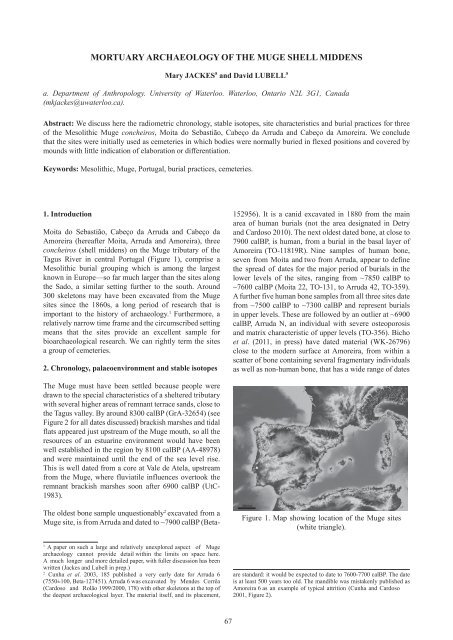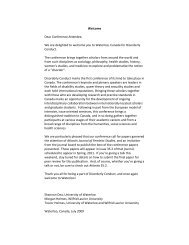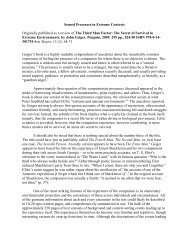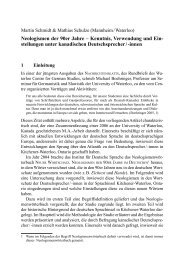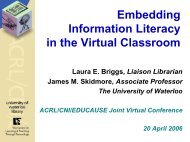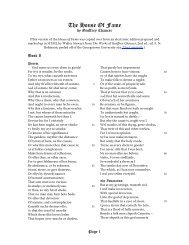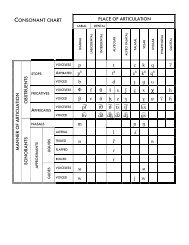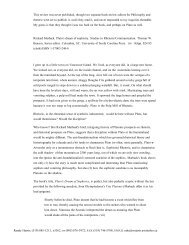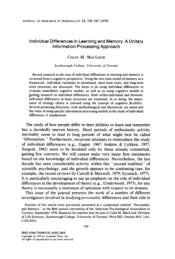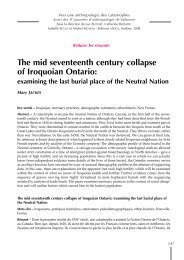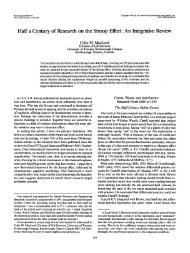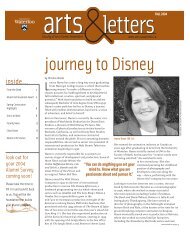mortuary archaeology of the muge shell middens - University of ...
mortuary archaeology of the muge shell middens - University of ...
mortuary archaeology of the muge shell middens - University of ...
You also want an ePaper? Increase the reach of your titles
YUMPU automatically turns print PDFs into web optimized ePapers that Google loves.
1. Introduction<br />
MORTUARY ARCHAEOLOGY OF THE MUGE SHELL MIDDENS<br />
Moita do Sebastião, Cabeço da Arruda and Cabeço da<br />
Amoreira (hereafter Moita, Arruda and Amoreira), three<br />
concheiros (<strong>shell</strong> <strong>middens</strong>) on <strong>the</strong> Muge tributary <strong>of</strong> <strong>the</strong><br />
Tagus River in central Portugal (Figure 1), comprise a<br />
Mesolithic burial grouping which is among <strong>the</strong> largest<br />
known in Europe—so far much larger than <strong>the</strong> sites along<br />
<strong>the</strong> Sado, a similar setting fur<strong>the</strong>r to <strong>the</strong> south. Around<br />
300 skeletons may have been excavated from <strong>the</strong> Muge<br />
sites since <strong>the</strong> 1860s, a long period <strong>of</strong> research that is<br />
important to <strong>the</strong> history <strong>of</strong> <strong>archaeology</strong>. 1 Fur<strong>the</strong>rmore, a<br />
relatively narrow time frame and <strong>the</strong> circumscribed setting<br />
means that <strong>the</strong> sites provide an excellent sample for<br />
bioarchaeological research. We can rightly term <strong>the</strong> sites<br />
a group <strong>of</strong> cemeteries.<br />
2. Chronology, palaeoenvironment and stable isotopes<br />
The Muge must have been settled because people were<br />
drawn to <strong>the</strong> special characteristics <strong>of</strong> a sheltered tributary<br />
with several higher areas <strong>of</strong> remnant terrace sands, close to<br />
<strong>the</strong> Tagus valley. By around 8300 calBP (GrA-32654) (see<br />
Figure 2 for all dates discussed) brackish marshes and tidal<br />
flats appeared just upstream <strong>of</strong> <strong>the</strong> Muge mouth, so all <strong>the</strong><br />
resources <strong>of</strong> an estuarine environment would have been<br />
well established in <strong>the</strong> region by 8100 calBP (AA-48978)<br />
and were maintained until <strong>the</strong> end <strong>of</strong> <strong>the</strong> sea level rise.<br />
This is well dated from a core at Vale de Atela, upstream<br />
from <strong>the</strong> Muge, where fluviatile influences overtook <strong>the</strong><br />
remnant brackish marshes soon after 6900 calBP (UtC-<br />
1983).<br />
The oldest bone sample unquestionably 2 excavated from a<br />
Muge site, is from Arruda and dated to ~7900 calBP (Beta-<br />
1 A paper on such a large and relatively unexplored aspect <strong>of</strong> Muge<br />
<strong>archaeology</strong> cannot provide detail within <strong>the</strong> limits on space here.<br />
A much longer and more detailed paper, with fuller discussion has been<br />
written (Jackes and Lubell in prep.)<br />
2 Cunha et al. 2003, 185 published a very early date for Arruda 6<br />
(7550±100, Beta-127451). Arruda 6 was excavated by Mendes Corrêa<br />
(Cardoso and Rolão 1999/2000, 178) with o<strong>the</strong>r skeletons at <strong>the</strong> top <strong>of</strong><br />
<strong>the</strong> deepest archaeological layer. The material itself, and its placement,<br />
Mary JACKES a and David LUBELL a<br />
a. Department <strong>of</strong> Anthropology. <strong>University</strong> <strong>of</strong> Waterloo. Waterloo, Ontario N2L 3G1, Canada<br />
(mkjackes@uwaterloo.ca).<br />
Abstract: We discuss here <strong>the</strong> radiometric chronology, stable isotopes, site characteristics and burial practices for three<br />
<strong>of</strong> <strong>the</strong> Mesolithic Muge concheiros, Moita do Sebastião, Cabeço da Arruda and Cabeço da Amoreira. We conclude<br />
that <strong>the</strong> sites were initially used as cemeteries in which bodies were normally buried in flexed positions and covered by<br />
mounds with little indication <strong>of</strong> elaboration or differentiation.<br />
Keywords: Mesolithic, Muge, Portugal, burial practices, cemeteries.<br />
67<br />
152956). It is a canid excavated in 1880 from <strong>the</strong> main<br />
area <strong>of</strong> human burials (not <strong>the</strong> area designated in Detry<br />
and Cardoso 2010). The next oldest dated bone, at close to<br />
7900 calBP, is human, from a burial in <strong>the</strong> basal layer <strong>of</strong><br />
Amoreira (TO-11819R). Nine samples <strong>of</strong> human bone,<br />
seven from Moita and two from Arruda, appear to define<br />
<strong>the</strong> spread <strong>of</strong> dates for <strong>the</strong> major period <strong>of</strong> burials in <strong>the</strong><br />
lower levels <strong>of</strong> <strong>the</strong> sites, ranging from ~7850 calBP to<br />
~7600 calBP (Moita 22, TO-131, to Arruda 42, TO-359).<br />
A fur<strong>the</strong>r five human bone samples from all three sites date<br />
from ~7500 calBP to ~7300 calBP and represent burials<br />
in upper levels. These are followed by an outlier at ~6900<br />
calBP, Arruda N, an individual with severe osteoporosis<br />
and matrix characteristic <strong>of</strong> upper levels (TO-356). Bicho<br />
et al. (2011, in press) have dated material (WK-26796)<br />
close to <strong>the</strong> modern surface at Amoreira, from within a<br />
scatter <strong>of</strong> bone containing several fragmentary individuals<br />
as well as non-human bone, that has a wide range <strong>of</strong> dates<br />
Figure 1. Map showing location <strong>of</strong> <strong>the</strong> Muge sites<br />
(white triangle).<br />
are standard: it would be expected to date to 7600-7700 calBP. The date<br />
is at least 500 years too old. The mandible was mistakenly published as<br />
Amoreira 6 as an example <strong>of</strong> typical attrition (Cunha and Cardoso<br />
2001, Figure 2).
Funerary practices in <strong>the</strong> iberian peninsula From <strong>the</strong> mesolithic to <strong>the</strong> chalcolithic<br />
Sample Years bp Years cal BP a<br />
and stable isotope values. We estimate <strong>the</strong> marine<br />
component for <strong>the</strong> diet <strong>of</strong> WK-26796 as 43% (based on<br />
Martins et al. 2008, Table 2 and our broader δ 13 C range<br />
-21.7 to -10.1), giving a date <strong>of</strong> ~7000 calBP.<br />
Thus we have something close to <strong>the</strong> complete range <strong>of</strong><br />
time for a Muge estuarine environment. While <strong>the</strong> material<br />
to be discussed for <strong>the</strong> most part dates from <strong>the</strong> earlier<br />
period, beginning about ~7900 calBP, it is important<br />
to understand whe<strong>the</strong>r <strong>the</strong> Muge materials discussed<br />
here can be called Mesolithic. Amoreira may provide us<br />
with <strong>the</strong> best sample <strong>of</strong> human material from <strong>the</strong> later<br />
period. Unfortunately, a great deal <strong>of</strong> it has been lost<br />
(Jackes et al. in press a, Roksandic and Jackes in press).<br />
Never<strong>the</strong>less, what remains indicates that diets were<br />
within <strong>the</strong> Mesolithic regime, based on degree and type <strong>of</strong><br />
dental attrition: e.g., <strong>the</strong>re is no cupped wear <strong>of</strong> “milled”<br />
posterior teeth as seen in <strong>the</strong> Neolithic (Lubell et al. 1994).<br />
Stable isotopes indicate considerable diversity in <strong>the</strong> Muge<br />
diet (Figure 3), Moita being relatively homogeneous, but<br />
Arruda having a wider range. Moita CT is an outlier,<br />
heavily marine and <strong>the</strong> youngest <strong>of</strong> all Moita dated burials<br />
(TO-135, ~7412 calBP). Three Arruda samples fall within<br />
<strong>the</strong> Moita range, but all o<strong>the</strong>rs are markedly shifted from<br />
a marine towards, but not within, a terrestrial diet. The<br />
most terrestrial, Arruda D (TO-355, ~7524 calBP), is<br />
however firmly within <strong>the</strong> Mesolithic time range, while<br />
<strong>the</strong> youngest, Arruda N (TO-356, ~6900 calBP) has one <strong>of</strong><br />
midpoint <strong>of</strong><br />
1 σ range<br />
Table 1. Radiocarbon dates discussed in text in order <strong>of</strong> mention<br />
Figure 2. Radiocarbon dates discussed in text in order <strong>of</strong> mention.<br />
68<br />
Years cal BP<br />
1 σ range<br />
Years cal BP<br />
2 σ range<br />
Source<br />
GrA-32654 Borehole 0501.025 (plant remains) 7440±40 8262 8203–8322 8181–8350 Vis and Kasse (2009)<br />
AA-48978 MUG-5 (plant & wood fragments) 7318±44 8114 8050–8177 8014–8277 Van der Schreik et al. (2008)<br />
UtC-1983 Alpiarça III peat 6040±50 6874 6798–6949 6600–6320 Vis et al. (2008)<br />
Beta-152956 Cabeço da Arruda canid 7070±40 7904 7858–7951 7798–7971 Detry and Cardoso (2010)<br />
Δ δ<br />
TO-11819R Cabeço da Amoreira CAM-00-01 7300±80 7886<br />
Δ δ<br />
TO-131 Moita do Sebastião Ossada 22 7240±70 7841<br />
Δ δ<br />
TO-359 Cabeço da Arruda Ossada 42 6960±70 7628<br />
Δ δ<br />
TO-356 Cabeço da Arruda N 6360±80 6931<br />
Δ δ<br />
WK-26796 Cabeço da Amoreira human 6329±40 7016<br />
Δ δ<br />
TO-135 Moita do Sebastião CT 6810±70 7412<br />
Δ δ<br />
TO-355 Cabeço da Arruda D 6780±80 7524<br />
Δ δ<br />
TO-10225 Cabeço da Amoreira CAM-01-01 6550±70 7364<br />
a Calibrations use Calib Rev 6.0.2 (Reimer et al. 2009; http://calib.qub.ac.uk/calib/) with IntCal09 and Marine09.<br />
Δ Correction for ΔR = 140±40 used<br />
δ δ 13 C range -21.7 to -10.1<br />
CORRECT FIGURE 2<br />
7803–7968 7695–8029 Meiklejohn et al. (2009)<br />
7759–7923 7679–7955 Lubell et al. (1994)<br />
7573–7682 7507–7781 Lubell et al. (1994)<br />
6801–7061 6740–7161 Lubell et al. (1994)<br />
6896–7136 6865–7153 Bicho et al. (2011a,b)<br />
7336–7487 7287–7559 Lubell et al. (1994)<br />
7462–7586 7424–7660 Lubell et al. (1994)<br />
7304–7425 7183–7486 Roksandic (2006)<br />
<strong>the</strong> most extreme <strong>of</strong> all Muge diets in term <strong>of</strong> <strong>the</strong> marine<br />
component. Amoreira samples range up to <strong>the</strong> highest<br />
marine component diet, close to 60%, but <strong>the</strong>y form a tight<br />
cluster, except for one (TO-10225 for CAM-01-01, 7365<br />
calBP). This is an extreme outlier and comes from within<br />
<strong>the</strong> disturbed scatter <strong>of</strong> faunal and human material, close<br />
to <strong>the</strong> surface, mentioned above. The stable isotope values<br />
are virtually identical to two faunal samples from within<br />
<strong>the</strong> same scatter, one at least 500 years younger and<br />
<strong>the</strong> o<strong>the</strong>r about 500 years older than TO-10225 (TO-11861<br />
and TO-11862, respectively, calculated without reservoir<br />
<strong>of</strong>fset, unpublished, Roksandic pers. comm.). We assume<br />
that WK-26796 (Bicho et al. 2011) is from <strong>the</strong> same scatter<br />
and we would suggest that it dates to ~7000 calBP but has<br />
a dietary marine component double that <strong>of</strong> TO-10225.<br />
While <strong>the</strong>re is no reason to doubt <strong>the</strong> provenance<br />
<strong>of</strong> <strong>the</strong> sample provided for <strong>the</strong> stable isotope analysis <strong>of</strong><br />
TO-10225 (Amoreira 2001 #139, Roksandic pers. com.),<br />
reanalysis <strong>of</strong> material from that fragmentary skeleton<br />
would confirm that <strong>the</strong>re was no laboratory confusion.<br />
To summarize, <strong>the</strong> Muge Mesolithic chronology can be<br />
tied to <strong>the</strong> period <strong>of</strong> estuarine resource availability, ~8100<br />
to ~6800 calBP. Arruda bone dates range from 7900 to<br />
6931 calBP; Moita bone dates cluster around 7800 calBP<br />
with an outlier at 7412 calBP; Amoreira dates appear to<br />
cover two periods, one starting around 7900 calBP and<br />
<strong>the</strong>n ano<strong>the</strong>r at perhaps 7500 calBP extending to ~6800<br />
calBP.<br />
3
3. Site characteristics<br />
Amoreira has more evidence <strong>of</strong> burials spread throughout<br />
<strong>the</strong> depth <strong>of</strong> <strong>the</strong> deposits, but <strong>the</strong> poorer evidence for upper<br />
level burials at Moita and Arruda has to be considered in<br />
terms <strong>of</strong> excavation history and site disruption. Arruda was<br />
excavated a number <strong>of</strong> times from 1863 to 2001, while<br />
Moita was excavated from 1880 to <strong>the</strong> 1950s, when much<br />
<strong>of</strong> <strong>the</strong> midden was removed by bulldozing. Amoreira was<br />
not extensively dug in <strong>the</strong> 19th century because no burials<br />
were found.<br />
While all three high <strong>middens</strong> (cabeços) lie above what was<br />
a marsh with Holocene alluvium, each is unique in terms<br />
<strong>of</strong> its position along <strong>the</strong> Muge: Moita and Amoreira lie to<br />
<strong>the</strong> south <strong>of</strong> <strong>the</strong> original marsh and Arruda to <strong>the</strong> north;<br />
Amoreira overlooks an embayment, so that floods will act<br />
differently upon it than upon Moita; Arruda, on <strong>the</strong> north<br />
bank, is within a deeper and narrower embayment than<br />
Amoreira. Figure 4 summarizes some <strong>of</strong> <strong>the</strong> differences<br />
among <strong>the</strong> sites (Jackes in press, discusses biological<br />
heterogeneity). A major difference among <strong>the</strong> sites relates<br />
to <strong>the</strong> depth <strong>of</strong> anthropogenic deposits above <strong>the</strong> sterile<br />
terrace sands: while Moita and Amoreira had/ have a<br />
maximum thickness <strong>of</strong> not much over 3m, Arruda has at<br />
least 2m more depth <strong>of</strong> deposit.<br />
Various types <strong>of</strong> evidence provide a clear indication<br />
that <strong>the</strong> sites have been disturbed in a number <strong>of</strong> ways, but<br />
flooding has obviously been <strong>of</strong> importance, especially at<br />
Arruda. Roche (1974, 25) described how <strong>the</strong> excavated<br />
pr<strong>of</strong>ile collapsed as <strong>the</strong> underlying sand was washed<br />
CORRECT FIGURE 3<br />
69<br />
Mortuary <strong>archaeology</strong> <strong>of</strong> <strong>the</strong> Muge <strong>shell</strong> Middens<br />
Site Specimen Lab. ref. Years bp δ 13 C -21.7 to -10.1 a % marine Source<br />
Cabeço da Amoreira Esq. 6 -14.8 6.9 59.5 Umbelino et al. (2007)<br />
Cabeço da Amoreira Esq. 8 -15.6 6.1 52.6 Umbelino et al. (2007)<br />
Cabeço da Amoreira Esq. 4 -15.7 6.0 51.7 Umbelino et al. (2007)<br />
Cabeço da Amoreira CAM-00-01 TO-111819R 7300 ± 80 -16.3 5.4 46.6 Roksandic (2006)<br />
Cabeço da Amoreira Esq. 7 Beta-127450 6850 ± 40 -16.5 5.2 44.8 Umbelino et al. (2007)<br />
Cabeço da Amoreira CAM-01-01 TO-10225 6550 ± 70 -19.3 2.4 20.7 Roksandic (2006)<br />
Cabeço da Arruda Ossada N TO-356 6360 ± 80 -15.3 6.4 55.2 Lubell et al. (1994)<br />
Cabeço da Arruda Esq. 1 -15.7 6.0 51.7 Umbelino et al. (2007)<br />
Cabeço da Arruda Ossada 42 TO-359 6960 ± 70 -17.2 4.5 38.8 Lubell et al. (1994)<br />
Cabeço da Arruda Esq. 10 -17.2 4.5 38.8 Umbelino et al. (2007)<br />
Cabeço da Arruda Ossada III TO-360 6990 ± 110 -17.7 4.0 34.5 Lubell et al. (1994)<br />
Cabeço da Arruda CA-00-02 TO-10216 7040 ± 60 -17.9 3.8 32.8 Roksandic (2006)<br />
Cabeço da Arruda CA-00-01 TO-10217 6620 ± 60 -18.1 3.6 31.0 Roksandic (2006)<br />
Cabeço da Arruda Ossada D TO-355 6780 ± 80 -18.9 2.8 24.1 Lubell et al. (1994)<br />
Cabeço da Arruda Ossada A TO-354 6970 ± 60 -19.0 2.7 23.3 Lubell et al. (1994)<br />
Moita do Sebastião Ossada CT TO-135 6810 ± 70 -15.3 6.4 55.2 Lubell et al. (1994)<br />
Moita do Sebastião Ossada 22 TO-131 7240 ± 70 -16.1 5.6 48.3 Lubell et al. (1994)<br />
Moita do Sebastião Esq. 15 -16.2 5.5 47.4 Umbelino et al. (2007)<br />
Moita do Sebastião Esq. 10 -16.6 5.2 44.4 Umbelino et al. (2007)<br />
Moita do Sebastião Esq. 31 -16.7 5.0 43.3 Umbelino et al. (2007)<br />
Moita do Sebastião Ossada 41 TO-134 7160 ± 80 -16.7 5.0 43.1 Lubell et al. (1994)<br />
Moita do Sebastião Ossada 24 TO-132 7180 ± 70 -16.8 4.9 42.2 Lubell et al. (1994)<br />
Moita do Sebastião Esq. 16 (Porto) Beta-127449 7120 ± 40 -16.8 4.9 42.2 Cunha et al. (2003)<br />
Moita do Sebastião Ossada 29 TO-133 7200 ± 70 -16.9 4.8 41.4 Lubell et al. (1994)<br />
a Estimated end points for δ 13 C (Arneborg et al. 1999) used to establish % marine because range includes Portuguese Neolithic values.<br />
Table 2. Figure Radiocarbon 3. Radiocarbon chronology chronology and stable and isotope stable values isotope for Muge values Mesolithic for Muge burials Mesolithic discussed burials in text discussed in text.<br />
away in 1966, during a flood that was not among <strong>the</strong> 19<br />
medium to very high hazard floods between 1855 and 1997<br />
(Azevêdo et al. 2004). Reconstruction <strong>of</strong> <strong>the</strong> excavations<br />
at Arruda in <strong>the</strong> 1860s, 1880s, 1930s and 1960s (Jackes et<br />
al. nd.b) suggests that midden deposit loss is greater than<br />
can be accounted for by archaeological work. Flooding<br />
was noted at Amoreira in <strong>the</strong> 1930s (Gonçalves 1986,<br />
222) and <strong>the</strong> Roche pr<strong>of</strong>iles (Roche 1964-65; 1967) show<br />
erosional, as well as o<strong>the</strong>r disturbances to <strong>the</strong> complex<br />
stratigraphy at Amoreira. Roche, consistently mentioned<br />
disturbances at all sites. While flooding is unlikely to<br />
have affected Moita, <strong>the</strong> surface had clearly been heavily<br />
worked; for example, a quarry was recorded <strong>the</strong>re in 1880.<br />
Many archaeological prospections, some unrecorded, with<br />
poor evidence on <strong>the</strong> location <strong>of</strong> back dirt piles, add to<br />
<strong>the</strong> agricultural and aboricultural disruptions.<br />
Disturbances may in part explain <strong>the</strong> existence <strong>of</strong> stray<br />
bone. Stray material was discovered at Arruda from <strong>the</strong><br />
time <strong>of</strong> <strong>the</strong> very first excavations, and it is recorded that<br />
stray bones and those in poor condition were discarded<br />
(Oliveira 1889, 71) and reburied (Cardoso and Rolão<br />
1999/2000, 169, 172). These were most likely upper level<br />
materials since Roche (1974, 31) stated those were always<br />
in poorer shape than skeletons from <strong>the</strong> lower level. While<br />
we can assume that museum collections are incomplete<br />
with regard to upper level burials, we have records <strong>of</strong> some<br />
burials very close to <strong>the</strong> modern surface. At Arruda, CA-<br />
00-01 lay at 30cm, Roche’s material from level 5 lay just<br />
below 45cm from <strong>the</strong> surface and 19th century archival<br />
material records that local men had seen skeletons close<br />
to <strong>the</strong> modern surface at Arruda. At Amoreira, CAM-<br />
5
Funerary practices in <strong>the</strong> iberian peninsula From <strong>the</strong> mesolithic to <strong>the</strong> chalcolithic<br />
Site Elevations <strong>of</strong><br />
Quaternary<br />
terraces a<br />
Muge<br />
bed a<br />
m asl<br />
Deep<br />
burials<br />
m asl<br />
01-01 mentioned above, was one <strong>of</strong> several fragmentary<br />
individuals encountered toge<strong>the</strong>r mixed with faunal<br />
bone within 20-60cm depth, and Amoreira 2, 3 and 4<br />
excavated in <strong>the</strong> 1930s, were also exposed at 20-40cm<br />
below <strong>the</strong> surface.<br />
It seems unlikely that Mesolithic burials would be so<br />
shallow but <strong>the</strong> explanation may be found partly in cabeço<br />
shape. Deep within a cabeço, <strong>the</strong> burials at <strong>the</strong> lowest<br />
level on <strong>the</strong> terrace sands will be metres below <strong>the</strong> modern<br />
surface, but at cabeço edges, <strong>the</strong> same sands are exposed,<br />
so that some Arruda burials from 1880, although at<br />
<strong>the</strong> same deep level as <strong>the</strong> majority, close to <strong>the</strong> terrace<br />
surface, were not at great depths.<br />
Erosion will also have removed earlier surface deposits<br />
and Roche (1964-65, 199) considered that disconformities<br />
showed that cabeços were restructured in Mesolithic<br />
times. However, <strong>the</strong>re were clearly burials into deposits<br />
well above <strong>the</strong> terrace sands.<br />
Our reconstruction <strong>of</strong> burials is that <strong>the</strong>y lay in very<br />
shallow graves, at best no more than hollows, close to<br />
features—hearths, pits and post holes found by Roche<br />
at Moita (Roche 1972a) and at Amoreira both by 1930s<br />
excavators (e.g. Gonçalves 1986, Document II-b) and<br />
Bicho et al. (2011). For closely adjacent decomposing<br />
cadavers to be tolerable for <strong>the</strong> living, mounds must have<br />
been constructed over graves. There is no indication <strong>of</strong><br />
disturbance by scavengers: any disturbance must be a<br />
consequence <strong>of</strong> later burials, erosion or digging within<br />
historical periods. We can support <strong>the</strong> hypo<strong>the</strong>sis <strong>of</strong> grave<br />
mounds fur<strong>the</strong>r by referring to heavy fill packed around<br />
some skeletons maintaining bones in place, and sediment<br />
weight pushing down on o<strong>the</strong>r skeletal elements.<br />
In some cases, <strong>the</strong>re may have been terrace pebbles<br />
included in <strong>the</strong> burial mound and ‘grave’ fill. Quartz<br />
and quartzite pebbles up to 12cm in size were exposed<br />
in Facies 1B and 8 in <strong>the</strong> Tagus lag channels (Vis and<br />
Kasse 2009) and <strong>the</strong>y were <strong>the</strong> raw materials used for<br />
some tool making. Pereira da Costa (1865) mentioned a<br />
layer containing fire-cracked rocks above <strong>the</strong> low burial<br />
level and Ribeiro (1884, 288) noted that <strong>the</strong> larger pebbles<br />
must have been brought to <strong>the</strong> Muge sites. While<br />
Distance <strong>of</strong> closest<br />
deep burials when first<br />
excavated<br />
from Paul do Duque<br />
(marsh) m<br />
70<br />
Roche (1951, 1963, 1964-65, 1972b) discussed pebbles in<br />
several contexts, <strong>the</strong>re is no mention <strong>of</strong> rocks specifically<br />
associated with graves. However, from Roche’s pr<strong>of</strong>ile<br />
(1967) it is probable that pebbles lay within <strong>the</strong> mound<br />
covering his Skeleton 6 at Amoreira. More impressively,<br />
unpublished photographs 3 that we have identified as being<br />
Amoreira Skeletons 6 and 8 from <strong>the</strong> 1930s, confirm that<br />
up to ten quite large pebbles could be associated with<br />
a burial. Amoreira 6 had a pebble lying directly on <strong>the</strong><br />
left scapular blade, which had collapsed outwards during<br />
decomposition. There may be ano<strong>the</strong>r stone in <strong>the</strong> neck<br />
region.<br />
4. Disposition <strong>of</strong> cadavers<br />
4.1. Upper body<br />
Height <strong>of</strong> deep<br />
burials above Paul do<br />
Duque (marsh)<br />
m<br />
Highest point <strong>of</strong><br />
cabeço<br />
m asl b<br />
Moita T4 (20-30 m ) ~4.2 21 80 16 now 21.5,<br />
was 24.5<br />
Amoreira T4 (20-30 m ) ~4.2 16-17 93 14 22.22<br />
Arruda T5 (12-15 m) ~4.5 ~9-10<br />
(1880)<br />
~21<br />
(1880)<br />
a Van der Schriek et al. (2008) b A discussion <strong>of</strong> sources will be published in Jackes and Lubell (in prep.).<br />
Figure 4. Site situation and characteristics.<br />
~3.25<br />
(1880)<br />
~15.0<br />
We have no evidence <strong>of</strong> grave architecture beyond shallow<br />
pits at Moita. At Arruda, natural hollows, sometimes at<br />
an angle, were occasionally used. In a few cases, we<br />
can see what is called a ‘wall effect’, meaning that bones<br />
are held in position despite <strong>the</strong> effects <strong>of</strong> decompositional<br />
disarticulation and movement. For example, an ilium<br />
may be maintained in an in vivo orientation (Jackes et al.<br />
in press b). Here <strong>the</strong> evidence is that sediments, heavily<br />
charged with <strong>shell</strong>, ash and charcoal, perhaps very humid<br />
because <strong>of</strong> <strong>the</strong> season <strong>of</strong> burial, were packed against a<br />
bone, preventing it from falling outwards. We also note<br />
cases in which <strong>the</strong> upper part <strong>of</strong> <strong>the</strong> body was kept within<br />
a constrained space, <strong>the</strong> humeri still pressed against <strong>the</strong><br />
ribs, <strong>the</strong> ribs <strong>the</strong>mselves slumped down somewhat, ra<strong>the</strong>r<br />
than outwards, and <strong>the</strong> clavicles ‘verticalized’ as seen at<br />
Amoreira (Roksandic and Jackes in press). Instead <strong>of</strong> lying<br />
across <strong>the</strong> shoulders, <strong>the</strong> clavicles may move, to varying<br />
degrees, into a cranio-caudal orientation. The frequency <strong>of</strong><br />
this at Amoreira suggests that <strong>the</strong> shallow grave pit was<br />
narrower around <strong>the</strong> shoulders and upper body than around<br />
<strong>the</strong> lower body.<br />
Of <strong>the</strong> Amoreira skeletons from <strong>the</strong> 1960s excavations for<br />
which <strong>the</strong> burial disposition can be ascertained, Skeletons<br />
6, 7, 8 (right side), probably 12 and certainly 13 have such<br />
3 In October 2010, while at <strong>the</strong> Museu de História Natural da Universidade<br />
do Porto, we were able to scan and identify a series <strong>of</strong> negatives and a few<br />
positives from 1930s excavations, mostly at Muge.
Figure 5. Amoreira Skeleton 6, excavated and<br />
photographed August 1933. Cropped from <strong>the</strong> scan <strong>of</strong> a<br />
photographic print incorrectly labelled Muge 1930/16,<br />
at <strong>the</strong> Museu de História Natural da Universidade<br />
do Porto. An unnumbered negative exists but has<br />
deteriorated. The skeleton lies in dark anthropogenic<br />
sediments just above <strong>the</strong> basal sands. The field notes<br />
record that <strong>the</strong> flexed skeleton was 90cm long.<br />
upper constriction. The photographs from <strong>the</strong> 1930s <strong>of</strong><br />
those few Amoreira skeletons which were undisturbed give<br />
us certain information only for Skeleton 6: this individual<br />
was apparently buried without upper body constriction<br />
(Figure 5).<br />
Moita skeletons from <strong>the</strong> 1950s (Jackes et al. in press<br />
b) provide ra<strong>the</strong>r contradictory evidence. There is partial<br />
constriction in Skeletons 30, 32, 5 and 12 but apparently<br />
none for Skeletons 31, and 15. On <strong>the</strong> o<strong>the</strong>r hand, full<br />
upper constriction is suggested for Skeletons 33, 3, 9,<br />
17 and 19. Skulls at Moita <strong>of</strong>ten lay on slight mounds <strong>of</strong><br />
sediment, but less <strong>of</strong>ten at Arruda (Roche 1974, 32). It<br />
is unfortunate that Arruda provides us with less evidence<br />
overall and lacks detailed analysis <strong>of</strong> burial disposition.<br />
However, we can say that upper body constriction is not<br />
obvious from photographs <strong>of</strong> <strong>the</strong> 1930s Arruda excavations<br />
and did not occur in <strong>the</strong> one group <strong>of</strong> skeletons excavated<br />
in 1880 for which we have a reasonable photograph.<br />
Published photographs <strong>of</strong> <strong>the</strong> 1960s Arruda excavations<br />
(Roche 1974, Plate 2; Cardoso and Rolão 1999/2000, 235,<br />
Figure 61) are not very clear, but certainly show some<br />
verticalized clavicles (Arruda 4) and evidence <strong>of</strong> bilateral<br />
constriction (Skeleton 7). Roche (1974, 33) stated that<br />
<strong>the</strong>re were no hollows dug to receive Arruda cadavers, a<br />
marked difference from Moita: thus we must assume that<br />
<strong>the</strong>re was tightly packed anthropogenic sediment around<br />
some bodies.<br />
Evidence on <strong>the</strong> position <strong>of</strong> hands, in those few cases<br />
where we can specify—34 right and 36 left hands across<br />
all three sites—provides us with no pattern <strong>of</strong> age, sex or<br />
site. There are five cases in which both hands are placed<br />
on <strong>the</strong> hips and five cases in which both hands extend<br />
71<br />
Mortuary <strong>archaeology</strong> <strong>of</strong> <strong>the</strong> Muge <strong>shell</strong> Middens<br />
beside <strong>the</strong> body. In one case (Arruda 1930s Skeleton 5)<br />
both hands are folded across <strong>the</strong> body. In 17 cases, <strong>the</strong> two<br />
hands are placed in different positions, most <strong>of</strong>ten on <strong>the</strong><br />
body ra<strong>the</strong>r than beside it. In roughly equal numbers 1.<br />
<strong>the</strong> upper hand is on <strong>the</strong> chest, opposite shoulder or upper<br />
arm, while <strong>the</strong> lower is on <strong>the</strong> abdomen, iliac blade or<br />
beside <strong>the</strong> body; 2. both hands are placed somewhere on<br />
<strong>the</strong> upper body, from <strong>the</strong> waist up; 3. both hands are placed<br />
low, on or beside <strong>the</strong> body. There is no consistency with<br />
regard to which hand is placed higher or lower – in all<br />
cases, when both hands can be observed and in <strong>the</strong> overall<br />
sample, <strong>the</strong> likelihood <strong>of</strong> left or right hand being placed<br />
higher is equal.<br />
4.2. Lower body<br />
Posture differences for <strong>the</strong> lower limbs were suggested<br />
in our original 1984-5 study <strong>of</strong> Muge skeletons (which<br />
did not focus on burial disposition): ‘...—based on our<br />
reconstructions—many <strong>of</strong> <strong>the</strong> Arruda skeletons were in<br />
extreme flexion <strong>of</strong> thigh on hip. However, for <strong>the</strong> Moita<br />
materials, we have found flexion only at <strong>the</strong> knees,<br />
suggesting that <strong>the</strong> bodies were buried fully extended,<br />
sometimes with raised knees’ (Lubell and Jackes 1988,<br />
245). While limited in scope, because many skeletons had<br />
been mixed and in most cases articulations maintained by<br />
breccia had been separated, our conclusion with regard to<br />
Moita may have been correct based on <strong>the</strong> later finding <strong>of</strong><br />
archival material (Jackes and Alvim 2006) which showed<br />
that a number <strong>of</strong> Moita skeletons had been laid one against<br />
ano<strong>the</strong>r, with crania leaning against <strong>the</strong> flexed-up knees<br />
<strong>of</strong> <strong>the</strong> individual behind. In comparison, a photograph <strong>of</strong><br />
Arruda in 1880 (Ribeiro 1884, Plates 1 and 2, parts <strong>of</strong> <strong>the</strong><br />
same image) shows burials illustrating why 19th century<br />
researchers spoke <strong>of</strong> <strong>the</strong> skeletons as being in ‘<strong>the</strong> most<br />
bizarre positions imaginable’ (Costa 1865, 15—our<br />
translation). In this photograph <strong>of</strong> one <strong>of</strong> three groupings<br />
<strong>of</strong> burials discovered in 1880, and <strong>the</strong> only photograph for<br />
which we have a clear image, <strong>the</strong>re is no evidence <strong>of</strong><br />
lateral constriction: ribs have slumped outwards, humeri<br />
have rolled out, ilia have fallen flat and clavicles have<br />
not shifted vertically. Yet <strong>the</strong> legs, both at hips and<br />
knees, are in extreme flexion indicating cranio-caudal,<br />
not lateral, constriction. In some cases, <strong>the</strong> legs might have<br />
fallen to <strong>the</strong> sides from an original position on <strong>the</strong> trunk,<br />
in o<strong>the</strong>rs a leg seems to have been initially placed firmly<br />
beside <strong>the</strong> body, keeping <strong>the</strong> ilium upright. In one burial,<br />
<strong>the</strong> sediment curved up under <strong>the</strong> pelvis and kept <strong>the</strong> legs<br />
on <strong>the</strong> trunk. Even in this one photographed Arruda 1880<br />
group we see ano<strong>the</strong>r burial disposition—lateral decubitus:<br />
this individual must have been laid with <strong>the</strong> legs folded to<br />
<strong>the</strong> left side.<br />
Unpublished 1930s photographs allow us to examine<br />
ten Arruda burials: some individuals were buried extended<br />
with knees semi-flexed, one was buried with feet set on<br />
<strong>the</strong> ground by <strong>the</strong> pelvis so that <strong>the</strong> knees must have been<br />
tightly flexed up at <strong>the</strong> time <strong>of</strong> burial. Two subadults had<br />
<strong>the</strong> femora hyperflexed onto <strong>the</strong> trunk. Arruda 9, from<br />
deep in <strong>the</strong> 1930s excavation, seems to be a bundle <strong>of</strong> long
Funerary practices in <strong>the</strong> iberian peninsula From <strong>the</strong> mesolithic to <strong>the</strong> chalcolithic<br />
bones with a fragment <strong>of</strong> mandible, while for Arruda 5,<br />
a juvenile, <strong>the</strong> bundle <strong>of</strong> hyperflexed lower limb bones<br />
was maintained in place by folded forearms. Since <strong>the</strong><br />
left talus is retained attached to <strong>the</strong> left posterior femoral<br />
neck and <strong>the</strong> ischial ramus, we know that <strong>the</strong> ankle was<br />
held above <strong>the</strong> hip. Extreme cranio-caudal constriction<br />
and tight hyperflexion <strong>of</strong> <strong>the</strong> thighs on <strong>the</strong> trunk is <strong>the</strong><br />
only explanation here, and indeed <strong>the</strong> 1884-85 Arruda<br />
excavator noted that <strong>the</strong> knees were held close to <strong>the</strong> face<br />
(Oliviera 1889, 73). All hips retaining an articulation in<br />
<strong>the</strong> Arruda collection at <strong>the</strong> Museu Geológico in Lisbon<br />
when we studied <strong>the</strong>m in 1985 had strong flexion <strong>of</strong><br />
femora at <strong>the</strong> hip. Some feet were also flexed up towards<br />
<strong>the</strong> tibiae. It is not possible to know whe<strong>the</strong>r <strong>the</strong> feet were<br />
set on <strong>the</strong> ground under flexed knees and pushed up by<br />
cranio-caudal curvature <strong>of</strong> <strong>the</strong> underlying sediments, or<br />
whe<strong>the</strong>r <strong>the</strong> thighs lay on <strong>the</strong> trunk, with <strong>the</strong> feet pushed<br />
against mounded sediment. In this position, <strong>the</strong> feet could<br />
not have been placed on <strong>the</strong> ground at burial (Roksandic<br />
and Jackes in press).<br />
Were cadavers buried with feet above <strong>the</strong> pelves, but<br />
knees parted, ra<strong>the</strong>r than on <strong>the</strong> trunk? An argument<br />
against this is that <strong>the</strong>re are cases where knees actually<br />
lay on <strong>the</strong> thorax when excavated, but <strong>the</strong>se are <strong>of</strong>ten<br />
subadults whose lesser muscle mass would have been a<br />
factor in maintaining <strong>the</strong> position. While it is possible<br />
that a ligature, or wrapping with hides, could have kept<br />
<strong>the</strong> body in this hyperflexed position, Roche, summarizing<br />
his Arruda burial findings, dismissed <strong>the</strong> idea <strong>of</strong> a ligature<br />
keeping <strong>the</strong> femora flexed against <strong>the</strong> trunk (1974, 32,<br />
34). There is no clear evidence <strong>of</strong> bundles requiring a hide<br />
wrapping, although <strong>the</strong> limb bones, especially <strong>of</strong> juveniles,<br />
may appear bundled. In <strong>the</strong> most likely case, from <strong>the</strong><br />
1880s Arruda excavations, a child with <strong>the</strong> mandible<br />
attached to <strong>the</strong> posterior left femoral shaft, in fact lies on<br />
<strong>the</strong> bones <strong>of</strong> a small female with her femur flexed on her<br />
hip and her right hand under her crossed feet. This cannot<br />
be a multiple secondary burial bundle; it must be an earlier<br />
burial disturbed by a later one. While one group<br />
<strong>of</strong> 1880 Arruda skeletons suggests alignment <strong>of</strong> separate<br />
individuals, so that each must have been well-marked<br />
for a sufficient length <strong>of</strong> time that later burials did not<br />
disturb earlier interments, this cannot have been true<br />
for o<strong>the</strong>r groupings, and certainly not for some <strong>of</strong> <strong>the</strong><br />
1930s skeletons. Fur<strong>the</strong>rmore, Arruda skeletal elements<br />
have most <strong>of</strong>ten fallen laterally, outwards, arguing against<br />
wrapping.<br />
Jackes et al. (in press b) considered <strong>the</strong> evidence on<br />
wrapping for <strong>the</strong> 1950s Moita burials and concluded that<br />
‘The best, and most parsimonious, argument…. seems to<br />
be that no coverings were placed over <strong>the</strong> bodies, and that<br />
<strong>the</strong> grave fill and subsiding mounds filled <strong>the</strong> voids slowly<br />
and at intervals, depending on particular circumstances,<br />
<strong>the</strong> season <strong>of</strong> <strong>the</strong> year, drainage and slight variations in<br />
<strong>the</strong> fill and mound construction’. In fact, <strong>the</strong> Moita burial<br />
disposition, as evidenced by <strong>the</strong> 1950s excavations, is that<br />
all but one <strong>of</strong> <strong>the</strong> dorsal decubitus burials had <strong>the</strong> knees<br />
flexed. The exception was an extended burial, although<br />
72<br />
one o<strong>the</strong>r skeleton had <strong>the</strong> knees very slightly raised. Most<br />
skeletons had <strong>the</strong> knees flexed upright and only one is<br />
likely to have had hyperflexion onto <strong>the</strong> trunk, a case<br />
where <strong>the</strong> knees apparently collapsed to <strong>the</strong> right. So<br />
at Moita, in most cases, <strong>the</strong> feet were placed flat on <strong>the</strong><br />
ground close to <strong>the</strong> pelvis. We postulate that this is <strong>the</strong><br />
modal burial posture for Moita.<br />
What can be gleaned <strong>of</strong> <strong>the</strong> Amoreira <strong>mortuary</strong> practices<br />
found in <strong>the</strong> 1960s has been summarized (Roksandic and<br />
Jackes in press). Only five burials can be discussed with<br />
any certainty, and <strong>of</strong> <strong>the</strong>se, four suggest constricted but<br />
shallow burial pits. Three adult females were buried<br />
with knees flexed, and a fourth was an extended burial.<br />
The flexed burials were not homogeneous since only two<br />
involved hyperflexion: Skeleton 6 had <strong>the</strong> knees side by<br />
side and <strong>the</strong> feet apparently raised and side by side, and<br />
Skeleton 12 must have had <strong>the</strong> feet raised and crossed,<br />
with <strong>the</strong> knees perhaps parted prior to decomposition.<br />
An Amoreira child, CAM-00-01, for which <strong>the</strong> suggestion<br />
is no wrapping and immediate covering with sediment<br />
(Roksandic 2006, 44 and Figure 1a), is a good example<br />
<strong>of</strong> asymmetry <strong>of</strong> <strong>the</strong> lower limbs. The feet are now<br />
in different positions, <strong>the</strong> left having fallen straight down,<br />
while <strong>the</strong> right lies on <strong>the</strong> sacrum. The right side <strong>of</strong> <strong>the</strong><br />
body makes it extremely unlikely that <strong>the</strong>re was wrapping,<br />
even though <strong>the</strong> right leg lay folded in such a way as to<br />
maintain <strong>the</strong> ilium in <strong>the</strong> in vivo position, generally <strong>the</strong><br />
same asymmetrical posture as in a subadult in Ribeiro’s<br />
Arruda photograph (1884, Plate 2). Our most interesting<br />
image (Figure 5) is <strong>of</strong> Amoreira 6 from <strong>the</strong> 1930s, a male<br />
skeleton, which gives a faulty impression <strong>of</strong> symmetry in<br />
<strong>the</strong> lower limbs. The right iliac blade, but not <strong>the</strong> left, is<br />
flat; <strong>the</strong> right femur has moved, but not <strong>the</strong> left, perhaps<br />
because <strong>the</strong> left elbow stabilized <strong>the</strong> leg (as with CAM-<br />
00-01). In this rare case <strong>of</strong> observable feet, we can see that<br />
ankles fell onto <strong>the</strong> sacrum, with each foot pointing away<br />
from <strong>the</strong> sacrum: it appears that <strong>the</strong> left foot lies with <strong>the</strong><br />
plantar surface up, on <strong>the</strong> left proximal femur. The posture<br />
<strong>of</strong> <strong>the</strong> feet suggests that <strong>the</strong> earth must have been firmly<br />
packed against <strong>the</strong>m in order to keep <strong>the</strong>m from falling<br />
caudally, as <strong>the</strong>y moved from <strong>the</strong>ir initial flexed position<br />
above <strong>the</strong> body. The feet must have fallen laterally into<br />
empty space provided by decomposition <strong>of</strong> <strong>the</strong> lower body<br />
tissues.<br />
Three more Amoreira skeletons from <strong>the</strong> 1930s can<br />
be discussed from information in <strong>the</strong> field note books<br />
(Cardoso and Rolão 1999/2000) and on <strong>the</strong> basis<br />
<strong>of</strong> unpublished photographs. Two (Skeleton 7, an adult<br />
female and 8, an older male) 4 lie on <strong>the</strong>ir sides, <strong>the</strong>ir<br />
tightly flexed legs beside <strong>the</strong> thorax, to <strong>the</strong> right and<br />
left, respectively. The final skeleton that can be discussed<br />
is Amoreira 1930s Skeleton 9 (illustrated by Cunha and<br />
4 This information comes from Roksandic (pers. comm. January 2010)<br />
who examined <strong>the</strong> skeletons at <strong>the</strong> Department <strong>of</strong> Anthropology,<br />
Universidad de Coimbra. The material as it is now, in Porto, is too<br />
fragmentary and mixed to discuss in detail.
Cardoso 2001 as 9/A). This is an interesting child burial,<br />
dorsal decubitus, with <strong>the</strong> left and right hyperflexed legs<br />
both fallen to <strong>the</strong> right side <strong>of</strong> <strong>the</strong> thorax. The phalanges<br />
<strong>of</strong> <strong>the</strong> child are resting upon its left parietal, i.e., <strong>the</strong> body<br />
lay with <strong>the</strong> right arm wrapped behind <strong>the</strong> head, <strong>the</strong> only<br />
such case seen.<br />
4.3. Summary on body posture<br />
All <strong>the</strong>se details indicate that <strong>the</strong> slender bodies were<br />
placed in very compacted postures, after rigor mortis<br />
but before <strong>the</strong> development <strong>of</strong> gas in <strong>the</strong> trunk. The<br />
position <strong>of</strong> <strong>the</strong> corpse was maintained by <strong>the</strong> immediate<br />
construction <strong>of</strong> a mound ra<strong>the</strong>r than placement in anything<br />
more than a very shallow pit or natural hollow. Sometimes<br />
<strong>the</strong> sediment could be built up under <strong>the</strong> skull or under <strong>the</strong><br />
pelvis, at o<strong>the</strong>r times it was not shaped. We have no firm<br />
evidence <strong>of</strong> wrapping <strong>of</strong> <strong>the</strong> body, ra<strong>the</strong>r <strong>the</strong> opposite,<br />
with sediment mounded up to support <strong>the</strong> feet, although<br />
<strong>the</strong> weight <strong>of</strong> <strong>the</strong> limbs would no doubt have helped to<br />
keep <strong>the</strong> inert limbs, now very flaccid, in place until <strong>the</strong><br />
heavy sediment was layered up around <strong>the</strong> body.<br />
In summary, <strong>the</strong> disposition <strong>of</strong> <strong>the</strong> bodies suggested is:<br />
1. extended, more <strong>of</strong>ten with knees slightly flexed<br />
(very rare);<br />
2. knees tightly flexed with feet placed next to <strong>the</strong><br />
pelvis (more common, especially at Moita);<br />
3. legs hyperflexed at <strong>the</strong> hip (quite common at<br />
Arruda and Amoreira);<br />
4. lateral ra<strong>the</strong>r than dorsal decubitus, with legs<br />
flexed (rare);<br />
5. apparent bundle burials in rare cases, interpreted<br />
as a reorganization <strong>of</strong> bones disturbed by a later<br />
inhumation (very rare).<br />
Differences among sites can only be that <strong>of</strong> an impression,<br />
although <strong>the</strong> 1880 photographs tend to support Roche’s<br />
opinion (1974, 33) that at Arruda <strong>the</strong>re were no hollows<br />
to receive <strong>the</strong> bodies such as he had seen at Moita, and<br />
<strong>the</strong>re is very limited evidence for hyperflexion at Moita. It<br />
is not possible to specify differences between <strong>the</strong> basal and<br />
upper level burials at ei<strong>the</strong>r Amoreira or Arruda.<br />
4.4. Orientation<br />
Most authors have noted orientation <strong>of</strong> bodies, starting<br />
with Pereira da Costa (1865, 13) who maintained that<br />
Arruda skulls were in general to <strong>the</strong> NW <strong>of</strong> <strong>the</strong> postcrania. A<br />
group <strong>of</strong> nine skeletons excavated in 1880 also apparently<br />
had skulls oriented to <strong>the</strong> NW, but <strong>the</strong> two o<strong>the</strong>r groups<br />
<strong>of</strong> skeletons found that year were not clearly aligned or<br />
oriented, one group being <strong>of</strong> tightly packed skeletons<br />
seemingly oriented at random (Jackes et al. nd.b). In <strong>the</strong><br />
skeleton group found at Moita in 1880, bodies generally<br />
lay with heads to <strong>the</strong> S (Jackes and Alvim 2006, Figure<br />
1). The 20th century excavations <strong>of</strong>ten provided exact<br />
information, so that we know that at Moita (Roche 1972a,<br />
130) 14 <strong>of</strong> <strong>the</strong> skeletons had <strong>the</strong>ir heads between <strong>the</strong> N<br />
73<br />
Mortuary <strong>archaeology</strong> <strong>of</strong> <strong>the</strong> Muge <strong>shell</strong> Middens<br />
and <strong>the</strong> W, with <strong>the</strong> majority (9/14) directly to <strong>the</strong> NW.<br />
However, even within <strong>the</strong> main grouping, orientations<br />
differed, so we cannot say that each group had a<br />
specific orientation. At Arruda, <strong>the</strong> deep burials (Roche<br />
1974, 26) had <strong>the</strong>ir heads generally to <strong>the</strong> N, while <strong>the</strong><br />
three upper level skeletons were NW, W and SW. Only<br />
four <strong>of</strong> <strong>the</strong> 1930s Arruda skeletons can be listed here<br />
with full certainty, and <strong>the</strong> directions were N, W, E and<br />
NE. It is possible to determine that <strong>the</strong> four upper<br />
level 1960s Amoreira skeletons were mostly laid with<br />
<strong>the</strong>ir skulls to <strong>the</strong> SE, just one <strong>of</strong> <strong>the</strong>m heading NW.<br />
The twelve lower level 1960s skeletons for which we have<br />
information were highly variable, none to <strong>the</strong> NW and<br />
only five to <strong>the</strong> N or NE. The recorded orientation <strong>of</strong><br />
upper level skeletons from Amoreira, five 1930s and<br />
four from <strong>the</strong> 1960s, is also variable, with four to <strong>the</strong> N or<br />
NW, and <strong>the</strong> rest <strong>of</strong> this sample <strong>of</strong> nine with <strong>the</strong> skulls to<br />
<strong>the</strong> E, S or, in three cases, SE.<br />
5. Grave goods<br />
Just as we see no evidence for any complexity to <strong>the</strong> grave<br />
structure at any <strong>of</strong> <strong>the</strong> three sites, <strong>the</strong>re is little evidence <strong>of</strong><br />
grave goods, but a mediating factor is how ‘grave goods’<br />
were identified or recognized. Paula e Oliveira (1889,<br />
73) noted that stone tools were to be found in greater<br />
numbers close to skeletons, but a lack <strong>of</strong> grave goods at<br />
Moita and Arruda was emphasized in <strong>the</strong> 19th century<br />
(Cartailhac 1886, Ribeiro 1884, 286), and Corrêa (1933,<br />
367) mentions only a few stone tools as examples <strong>of</strong> grave<br />
goods discovered at Amoreira in <strong>the</strong> first campaign. On<br />
<strong>the</strong> o<strong>the</strong>r hand, Roche (1956, 160) noted that Moita<br />
burials were accompanied by ochre and occasionally by<br />
<strong>the</strong> addition <strong>of</strong> <strong>shell</strong> fish beside <strong>the</strong> body. The situation<br />
at Moita was described in much greater detail in Roche’s<br />
1972 monograph: for example, Skeleton 14 has a great<br />
quantity <strong>of</strong> Scrobicularia associated with it. Most notably,<br />
small pierced Neritina fluviatilis were also found beside or<br />
over <strong>the</strong> bodies in six cases at Moita (Roche 1972a,<br />
132). Roche (1974, 33) stated that Arruda was different<br />
from Moita in that no ochre and no food provisions were<br />
found in Arruda graves, and noted only that a scraper<br />
was found with 1960s Arruda Skeleton 2 and a bone point<br />
under <strong>the</strong> left hand <strong>of</strong> Skeleton 7 (Roche 1972a, 28,<br />
29). However, Mendes Corrêa’s team had found perforated<br />
<strong>shell</strong>s close to <strong>the</strong> skull <strong>of</strong> an unnumbered Arruda<br />
child (Cardoso and Rolão 1999/2000, 178). The most<br />
impressive collection <strong>of</strong> pierced <strong>shell</strong>s is with <strong>the</strong> Moita<br />
25 child from <strong>the</strong> 1950s, still retained in <strong>the</strong> collections at<br />
<strong>the</strong> Museu de História Natural da Universidade do Porto<br />
but wrongly labelled 27 and listed by Ferembach (1974)<br />
as Moita 27. The legs were hyperflexed on <strong>the</strong> trunk and<br />
it was laid on what seems to have been a string <strong>of</strong> Neritina<br />
which extends from <strong>the</strong> left lower ribs around <strong>the</strong> left hip<br />
and under <strong>the</strong> sacrum.<br />
Since Roche did not publish a monograph on Amoreira,<br />
all we have is his list <strong>of</strong> grave goods at Moita and Arruda,<br />
mentioning small fires lit around three bodies at Moita,<br />
but making no reference at all to Amoreira (Roche 1972b,
Funerary practices in <strong>the</strong> iberian peninsula From <strong>the</strong> mesolithic to <strong>the</strong> chalcolithic<br />
100). Apart from Amoreira 1930s Skeleton 6, apparently<br />
underlain by much <strong>shell</strong> and charcoal, <strong>the</strong> Mendes Corrêa<br />
field notes do not mention materials associated with <strong>the</strong><br />
graves except for intrusive later artifacts. Never<strong>the</strong>less,<br />
Amoreira Skeleton 7 from <strong>the</strong> 1930s had a quite large<br />
burnt log lying close beside <strong>the</strong> left shoulder, but no o<strong>the</strong>r<br />
skeleton has a record <strong>of</strong> associated materials. In 2011,<br />
a skeleton was excavated by Bicho at Amoreira with<br />
lithics, <strong>shell</strong> fish and bones, interpreted as grave goods<br />
(Anonymous 2011). A deep burial excavated by Rolão<br />
at Amoreira in 2000 was not accompanied by such items<br />
(Roksandic pers. comm. 7/10/2011).<br />
6. Discussion and Conclusion<br />
We have looked briefly at <strong>the</strong> available evidence from<br />
three Muge Mesolithic sites. The sites survived because<br />
<strong>the</strong>y were established on remnant terraces above <strong>the</strong> Muge<br />
River. Their choice as burial places must relate to <strong>the</strong> fact<br />
that <strong>the</strong>y stood proud <strong>of</strong> <strong>the</strong> Muge valley, in Mesolithic<br />
times as today. Two o<strong>the</strong>r lower sites were identified and<br />
destroyed long ago, and two fur<strong>the</strong>r sites have recently<br />
been recognized (Gonçalves 2009), but it is <strong>the</strong> cabeços<br />
that stand out as burial places, arguing against mere<br />
preservation bias as an explanation. We imagine that<br />
<strong>the</strong> sites discussed here were, at <strong>the</strong> very least, <strong>the</strong> most<br />
important burial sites for <strong>the</strong> small Mesolithic groups that<br />
inhabited <strong>the</strong> Muge valley on a near-permanent basis. 5<br />
We have argued for <strong>the</strong> Muge as a base camp location<br />
because <strong>of</strong> <strong>the</strong> identity <strong>of</strong> <strong>the</strong> dead, males and females,<br />
neonates to <strong>the</strong> very elderly, <strong>the</strong> unhealthy as well as<br />
<strong>the</strong> healthy (Jackes and Lubell 1999). We add here <strong>the</strong><br />
argument that we see no sign <strong>of</strong> secondary burials. While<br />
we could suggest, based on demographic parameters,<br />
that some adults were buried where <strong>the</strong>y died at a<br />
distance, those buried on <strong>the</strong> cabeços were buried in-flesh,<br />
very soon after death. Burials were marked by mounds,<br />
built over cadavers that were generally folded to various<br />
degrees, to ensure that a mound was roughly circular or<br />
oval in shape. In some cases, <strong>the</strong> locations <strong>of</strong> prior burials<br />
were known, in o<strong>the</strong>r cases burials disturbed previous<br />
inhumations. Burials may be grouped, but <strong>the</strong>re is no<br />
evidence that <strong>the</strong> grouping was by age or sex, except in<br />
one case <strong>of</strong> childrens’ burials at Moita (Roche 1972a, 131,<br />
but o<strong>the</strong>r children lay elsewhere) found to one side <strong>of</strong><br />
what was evidently an arrangement <strong>of</strong> postholes, perhaps<br />
a windbreak, opening onto what seemed to be a U- shaped<br />
arrangement <strong>of</strong> burials (Jackes and Alvim 2006). It is not yet<br />
possible to have a similar understanding <strong>of</strong> <strong>the</strong> horizontal<br />
layout <strong>of</strong> burials at Amoreira or Arruda. The mounds over<br />
<strong>the</strong> dead were constructed <strong>of</strong> <strong>the</strong> materials that lay around<br />
– ash, charcoal, <strong>shell</strong>, sometimes fire-cracked rocks. It is<br />
this material that has built <strong>the</strong> cabeço <strong>middens</strong> up over<br />
what seems, for Moita and Arruda at least, to have been<br />
initially sites devoted to burials with, quite clearly, a great<br />
deal <strong>of</strong> debris from fires and meals. Many Moita burials<br />
5 Year-round availability <strong>of</strong> food resources has been noted by Lentacker<br />
(1986) and Detry (pers. comm. 26/10/2011).<br />
74<br />
were placed in <strong>the</strong> sterile terrace sands, but Arruda burials<br />
seem more <strong>of</strong>ten to have lain slightly above <strong>the</strong> sands.<br />
Are <strong>the</strong> supposed differences between <strong>the</strong> purposeful<br />
hollows at Moita and <strong>the</strong> apparent lack <strong>of</strong> any at Arruda<br />
related to <strong>the</strong> sediments in which people were buried? Our<br />
evidence on Moita comes from Roche’s 1950s excavations,<br />
in which <strong>the</strong> burials were all in <strong>the</strong> basal sands, many<br />
underlying a very hard breccia which only occurred in<br />
isolated nodules at o<strong>the</strong>r sites. Roche (1974, 27) attributed<br />
<strong>the</strong> breccias to <strong>the</strong> higher clay content <strong>of</strong> <strong>the</strong> Moita terrace<br />
sands. Arruda burials were initially found only in a narrow<br />
band lying just above <strong>the</strong> basal sands (Costa 1865). This<br />
is confirmed by archival material from <strong>the</strong> extensive 1880<br />
excavation showing that skeletons in one group were<br />
found within a level about a metre thick, just above<br />
<strong>the</strong> sands. The 1930s excavations found nine skeletons<br />
lying from 30cm to 1.4m above <strong>the</strong> basal sands (Cardoso<br />
and Rolão 1999/2000). Our limited understanding <strong>of</strong> <strong>the</strong><br />
Muge sites might lead us to over-emphasize this difference<br />
between Moita and Arruda, especially since Roche<br />
(1974, 27) states that his Arruda burials were on terrace<br />
sands, with anthropogenic sediments piled over <strong>the</strong> dead.<br />
However, <strong>the</strong>re are comparisons we can make. At Moita,<br />
where bodies were more extended, <strong>the</strong>y were buried<br />
in hollows in <strong>the</strong> sand and covered by more elongate<br />
burial mounds which included more sand. At Arruda and<br />
Amoreira, where lower level cadavers were tightly folded,<br />
<strong>the</strong> mounds were more compact and constructed from<br />
anthropogenic sediments that were firmly packed over<br />
<strong>the</strong> bodies. Such factors would help to explain differences<br />
in preservation and colouration, as well as <strong>the</strong> nature <strong>of</strong><br />
adherent breccias, between Moita and <strong>the</strong> o<strong>the</strong>r sites.<br />
It seems unlikely that people would have actually have<br />
been living at <strong>the</strong> focal points <strong>of</strong> <strong>the</strong> cabeços, surrounded<br />
by multiple shallow graves, each marked by an eroding<br />
mound. It is possible that after <strong>the</strong> initial use <strong>of</strong> <strong>the</strong> cabeços<br />
as burial places <strong>the</strong>re were periods during which <strong>the</strong>y<br />
became places to which pebbles were brought to construct<br />
hearths and <strong>the</strong>re was a rapid deposition <strong>of</strong> ash, charcoal,<br />
bone and <strong>shell</strong>, layers which could be shaped by erosion and<br />
were later disturbed by fur<strong>the</strong>r burials, perhaps especially<br />
at Amoreira, where <strong>the</strong> upper layer contains many<br />
pebbles, as noticed by Roche, by Rolão’s team, and<br />
now by Bicho’s team in <strong>the</strong>ir new controlled excavations.<br />
Acknowledgements<br />
We are grateful to Dr. Miguel Magalhães Ramalho,<br />
Coordenador, Museu Geológico, Instituto Nacional de<br />
Engenharia, Tecnologia e Inovação, Lisbon for permission<br />
to examine Muge materials. At <strong>the</strong> Museu de História<br />
Natural da Universidade do Porto A. H. Bacelar Gonçalves<br />
provided essential help to us in 1984 and his successor,<br />
Maria José Cunha has become an indispensable colleague.<br />
The archival photographs and negatives are used or<br />
referred to with <strong>the</strong> permission <strong>of</strong> Pr<strong>of</strong>. Doutor José Luís<br />
Santos, vice- director <strong>of</strong> <strong>the</strong> Faculdade de Ciências do<br />
Porto and funding for <strong>the</strong> scanning came from a bequest
from Es<strong>the</strong>r Palmer. Mirjana Roksandic and Cleia Detry<br />
have provided invaluable information. Funding for our<br />
research in 1984-9 was by Grants 410-84-0030 and 410-86-<br />
2017 from <strong>the</strong> Social Sciences and Humanities Research<br />
Council <strong>of</strong> Canada to Lubell, Jackes and Christopher<br />
Meiklejohn.<br />
References<br />
Anonymous 2011. http://www.publico.pt/Cultura/<br />
ha- uma-nova-interpretacao-sobre-os-concheiros-de-<br />
<strong>muge</strong>_1508169.<br />
Arneborg, J., Heinemeier, J., Lynnerup, N., Nielsen, H. L.,<br />
Rud, N. and Sveinbjörnsdóttir, A. E. 1999. Change <strong>of</strong><br />
diet <strong>of</strong> <strong>the</strong> Greenland Vikings determined from stable<br />
carbon isotope analysis and 14 C dating <strong>of</strong> <strong>the</strong>ir bones.<br />
Radiocarbon 41(2), 157–168.<br />
Azevêdo, T.M., Nunes E. and Ramos, C. 2004.<br />
Some morphological aspects and hydrological<br />
characterization <strong>of</strong> <strong>the</strong> Tagus floods in <strong>the</strong> Santarém<br />
region, Portugal. Natural Hazards 31, 587-601.<br />
Bicho, N., Cascalheira, J., Marreiros, J. and Pereira, T.<br />
2011. The 2008-2010 excavations <strong>of</strong> Cabeço da<br />
Amoreira, Muge, Portugal. Mesolithic Miscellany<br />
21(2), 3–13.<br />
Bicho, N., Pereira, T., Umbelino, C., Jesus, L., Marreiros,<br />
J., Cascalheira, J., Gonçalves, C. and Detry, C. In press.<br />
The construction <strong>of</strong> a <strong>shell</strong>midden: <strong>the</strong> case <strong>of</strong> Cabeço<br />
da Amoreira, Muge (Portugal). In P. Arias Cabal, M.<br />
Cueto, M.Á. Fano (eds.), Proceedings <strong>of</strong> <strong>the</strong> Eighth<br />
Conference on <strong>the</strong> Mesolithic in Europe. Oxford,<br />
Oxbow Books.<br />
Cardoso, J.L.and Rolão, J. M. 1999/2000. Prospecções<br />
e escavações no concheiros mesolíticos de Muge e<br />
de Magos (Salvaterra de Magos): contribuição para<br />
a história dos trabalhos arqueológicos efectuados.<br />
Estudos Arqueológicos de Oeiras 8, 83–240.<br />
Cartailhac, E. 1886. Les Âges Préhistoriques de lEspagne<br />
et du Portugal. Paris, Reinwald.<br />
Corrêa, A. M. 1933. Les nouvelles fouilles à<br />
Muge (Portugal). In XV Congrès International<br />
d’Anthropologie et d’Archéologie Préhistorique<br />
1931, 357–372.<br />
Costa, F.A.P. 1865. Da existencia do Homem em epochas<br />
remotas no Valle do Tejo. Primeiro Opusculo. Noticia<br />
sobre os esqueletos humanos descobertos no Cabeço<br />
da Arruda. Lisboa, Commissão Geológica de Portugal.<br />
Cunha, E. and Cardoso, F. 2001. The osteological series<br />
from Cabeco da Amoreira (Muge, Portugal). Bulletins<br />
et Mémoires la Société d’Anthropologie de Paris 13,<br />
323–333.<br />
Cunha, E., Cardoso, F. and Umbelino, C. 2003.<br />
Inferences about Mesolithic lifestyle on <strong>the</strong> basis <strong>of</strong><br />
anthropological data. The case <strong>of</strong> <strong>the</strong> Portuguese <strong>shell</strong><br />
<strong>middens</strong>. In L. Larsson, H. Kindgren, J. Knutsson,<br />
D. Loeffler and A. Åkerlund (eds.), Mesolithic on <strong>the</strong><br />
Move. Papers Presented at <strong>the</strong> Sixth International<br />
Conference on <strong>the</strong> Mesolithic in Europe, Stockholm<br />
2000, 184–188. Oxford, Oxbow Books.<br />
75<br />
Mortuary <strong>archaeology</strong> <strong>of</strong> <strong>the</strong> Muge <strong>shell</strong> Middens<br />
Detry, C. and Cardoso, J. L. 2010. On some remains <strong>of</strong> dog<br />
(Canis familiaris) from <strong>the</strong> Mesolithic <strong>shell</strong> <strong>middens</strong><br />
<strong>of</strong> Muge, Portugal. Journal <strong>of</strong> Archaeological Science<br />
37, 2762–2774.<br />
Ferembach, D. 1974. Le Gisement Mésolithique de Moita<br />
do Sebastião, Muge, Portugal. II Anthropologie.<br />
Lisboa, Direcção-Geral dos Assuntos Culturais.<br />
Gonçalves, A.A.H.B. 1986. Inéditos de Rui Serpa Pinto<br />
sobre as escavações archeológicas de Muge. Trabalhos<br />
de Antropologia e Etnologia 26, 211–229.<br />
Gonçalves, C. A. 2009. Modelos preditivos em sig na<br />
localização de sítios arqueológicos de cronologia<br />
Mesolítica no Vale do Tejo. Unpublished Master <strong>the</strong>sis,<br />
Universidade do Algarve.<br />
Jackes, M. In press. Muge Mesolithic heterogeneity:<br />
comparing Moita do Sebastião and Cabeço da<br />
Arruda. In P. Arias, M. Cueto and M. Á. Fano (eds.),<br />
Proceedings <strong>of</strong> <strong>the</strong> Eighth Conference on <strong>the</strong> Mesolithic<br />
in Europe. Oxford, Oxbow Books.<br />
Jackes, M. and Alvím P. 2006. Reconstructing Moita<br />
do Sebastião, <strong>the</strong> first step. In Do Epipalaeolítico<br />
ao Calcolítico na Península Iberica. Actas do IV<br />
Congresso de Arqueologia Peninsular, 13–26. Faro,<br />
Universidade do Algarve.<br />
Jackes, M., Alvim, P. and Cunha, M. J. In press a.<br />
Reconstructing Cabeço da Amoreira, 1930-1933. In P.<br />
Arias, M. Cueto and M.Á. Fano (eds.), Proceedings<br />
<strong>of</strong> <strong>the</strong> Eighth Conference on <strong>the</strong> Mesolithic in Europe.<br />
Oxford, Oxbow Books.<br />
Jackes, M., Alvim, P., Roksandic, M. and Anacleto, J. A.<br />
In press b. New photographic evidence on <strong>the</strong> 1954<br />
excavations at Moita do Sebastião. In M. Roksandic,<br />
S. Mendonça, S. Eggers, M. Burchell and D. Klokler<br />
(eds.) The cultural dynamics <strong>of</strong> <strong>shell</strong> <strong>middens</strong> and<br />
<strong>shell</strong> mounds: a worldwide perspective. Albuquerque,<br />
<strong>University</strong> <strong>of</strong> New Mexico Press.<br />
Jackes, M., Lubell, D., Cardoso, H. and Anacleto, J.A.<br />
nd.a. Cabeço da Arruda in <strong>the</strong> 1860s. Manuscript on<br />
file.<br />
Jackes, M., Alvim, P. and Lubell, D. nd.b. Cabeço da<br />
Arruda in <strong>the</strong> 1880s. Manuscript on file.<br />
Jackes, M. and Lubell, D. 1999. Human biological<br />
variability in <strong>the</strong> Portuguese Mesolithic. Arqueologia<br />
24, 25–42.<br />
Jackes, M. and Lubell, D. in prep. An overview <strong>of</strong> Muge<br />
burial practices. Manuscript on file.<br />
Lentacker, A. 1986. Preliminary results <strong>of</strong> <strong>the</strong> fauna <strong>of</strong><br />
Cabeço da Amoreira and Cabeço de Arruda (Muge,<br />
Portugal). Trabalhos de Antropologia e Etnologia<br />
26(1-4), 9–26.<br />
Lubell, D. and M. Jackes. 1988. Portuguese Mesolithic-<br />
Neolithic subsistence and settlement. Rivista di<br />
Antropologia 66, 231–248.<br />
Lubell, D., Jackes, M., Schwarcz, H., Knyf, M. and<br />
Meiklejohn, C. 1994. The Mesolithic-Neolithic<br />
transition in Portugal: isotopic and dental evidence <strong>of</strong><br />
diet. Journal <strong>of</strong> Archaeological Science 21(2), 201–<br />
216.
Funerary practices in <strong>the</strong> iberian peninsula From <strong>the</strong> mesolithic to <strong>the</strong> chalcolithic<br />
Martins, J. M. M., Carvalho, A. F. and Soares, A.M.M.<br />
2008. A calibração das datas de radiocarbono dos<br />
esqueletos humanos de Muge. Promontoria 6, 73–93.<br />
Meiklejohn, C., Roksandic, M., Jackes, M. and Lubell,<br />
D. 2009. Radiocarbon dating <strong>of</strong> Mesolithic human<br />
remains in Portugal. Mesolithic Miscellany 20(1),<br />
4–16.<br />
Oliveira, F. de P. 1889. Nouvelles fouilles faites<br />
dans les kioekkenmoeddings de la Vallée du Tage.<br />
Communicações da Commissão dos Trabalhos<br />
Geologicos 2, 57–81.<br />
Reimer, P. J., Baillie, M. G. L., Bard, E., Bayliss, A., Beck,<br />
J. W., Blackwell, P. G., Bronk-Ramsey, C., Buck, C.<br />
E., Burr, G. S., Edwards, R. L., Friedrich, M., Grootes,<br />
P. M., Guilderson, T. P., Hajdas, I., Heaton, T. J.,<br />
Hogg, A. G., Hughen, K. A., Kaiser, K. F., Kromer,<br />
B., McCormac, F. G., Manning, S. W., Reimer, R. W.,<br />
Richards, D. A., Southon, J. R., Talamo, S., Turney, C.<br />
S. M., van der Plicht, J. and Weyhenmeyer, C. E. 2009.<br />
IntCal09 and Marine09 radiocabon age calibration<br />
curves, 0-50,000 years cal BP. Radiocarbon 51, 1111–<br />
1150.<br />
Ribeiro, C. 1884. Les kjoekkenmoeddings de la vallée<br />
du Tage. In Congrès International d’Anthropologie et<br />
d’Archéologie Préhistoriques, Lisbonne. C.R. IX ème<br />
session 1880, 279–290. Lisbon, Académie Royale<br />
des Sciences.<br />
Roche, L’Abbé J. 1951. L’industrie préhistorique du<br />
Cabeço d’Amoreira (Muge). Porto, Centro de Estudos<br />
de Etnologia Peninsular.<br />
Roche, L’Abbé J. 1956. Récentes découvertes au<br />
gisement de Moita do Sebastião – Muge (Portugal). In<br />
Congresos Internacionales de Ciencias Prehistoricas y<br />
Protohistoricas, Actas de la IV Sesion, Madrid 1954,<br />
155–161.<br />
Roche, L’Abbé J. 1964-65. Note sur la stratigraphie de<br />
l’amas coquillier mésolithique de Cabeço da Amoreira<br />
(Muge). Comunicações dos Serviços Geológicos de<br />
Portugal 48,191–200.<br />
Roche, L’Abbé J. 1963. Le gisement mésolithique de<br />
Moita do Sebastião à Muge (Portugal). Les traces<br />
d’habitat et d’organisation sociale. Bulletin de la<br />
Société Préhistorique Française. 60, 68–73.<br />
Roche, L’Abbé J. 1967. Seconde note sur la stratigraphie de<br />
l’amas coquillier mésolithique de Cabeço da Amoreira<br />
(Muge). Communicações dos Serviços Geológicos de<br />
Portugal 51, 243–252.<br />
Roche, L’Abbé J. 1972a. Le Gisement Mésolithique de<br />
Moita do Sebastião, Muge, Portugal. I Archéologie.<br />
Lisboa, Direcção-Geral dos Assuntos Culturais.<br />
Roche, L’Abbé J. 1972b. Les amas coquilliers (concheiros)<br />
Mésolithiques de Muge (Portugal). In J. Lüning<br />
(ed.), Die Anfänge des Neolithikums vom Orient bis<br />
Nordeuropa, Teil VII, 72–107. Köln, Böhlau Verlag.<br />
Roche, L’Abbé J. 1974. Sépultures de l’amas coquillier<br />
mésolithique de Cabeço da Arruda (Muge). In Actas<br />
do Congresso Nacional de Arqueologia, 25–36. Porto.<br />
Roksandic, M. 2006. Analysis <strong>of</strong> burials from <strong>the</strong><br />
new excavations <strong>of</strong> <strong>the</strong> sites Cabeço da Amoreira<br />
76<br />
and Cabeço da Arruda (Muge, Portugal). In Do<br />
Epipaleolítico ao Calcolítico na Península Ibérica:<br />
Actas do IV Congresso de Arqueologia Peninsular,<br />
43–54. Faro, Universidade do Algarve.<br />
Roksandic, M. and Jackes M. In press. The skeletal<br />
assemblage and burial ritual at <strong>the</strong> site <strong>of</strong> Cabeço da<br />
Amoreira: <strong>the</strong> 1960s excavations by Veiga Fereira and<br />
Roche. In M. Roksandic, S. Mendonça, S. Eggers, M.<br />
Burchell and D. Klokler (eds.) The cultural dynamics<br />
<strong>of</strong> <strong>shell</strong> <strong>middens</strong> and <strong>shell</strong> mounds: a worldwide<br />
perspective. Albuquerque, <strong>University</strong> <strong>of</strong> New Mexico<br />
Press.<br />
Umbelino, C., Pérez-Pérez, A., Cunha, E., Hipólito, C.,<br />
Freitas, M. do C. and Cabral, J.P. 2007. Outros sabores<br />
do passado: um novo olhar sobre as comunidades<br />
humanas mesolíticas de Muge e do Sado através de<br />
análises químicas dos ossos. Promontoria 5, 45–90.<br />
Van der Schriek, T., Passmore, D.G., Mugica, F.F.,<br />
Stevenson, A.C., Boomer, I. and Rolão, J. 2008.<br />
Holocene palaeoecology and floodplain evolution<br />
<strong>of</strong> <strong>the</strong> Muge tributary, Lower Tagus Basin, Portugal.<br />
Quaternary International 189,135–151.<br />
Vis, G-J., Kasse, C. and Vandenberghe, J. 2008. Late<br />
Pleistocene and Holocene palaeogeography <strong>of</strong> <strong>the</strong><br />
Lower Tagus Valley (Portugal); Effects <strong>of</strong> relative<br />
sea level, valley morphology and sediment supply.<br />
Quaterary Science Reviews 27, 1682–1709.<br />
Vis, G-J. and Kasse, C. 2009. Late Quaternary valley-<br />
fill succession <strong>of</strong> <strong>the</strong> Lower Tagus Valley, Portugal.<br />
Sedimentary Geology 221, 19–39.


